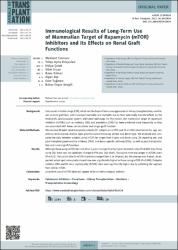| dc.contributor.author | Tanrısev, Mehmet | |
| dc.contributor.author | Ayna Kılıçaslan, Tülay | |
| dc.contributor.author | Çolak, Hülya | |
| dc.contributor.author | Ersan, Sibel | |
| dc.contributor.author | Yılmaz, Banu | |
| dc.contributor.author | Alp, Alper | |
| dc.contributor.author | Tuğmen, Cem | |
| dc.contributor.author | Engin Sevgili, Bahar | |
| dc.date.accessioned | 2021-10-21T10:39:44Z | |
| dc.date.available | 2021-10-21T10:39:44Z | |
| dc.date.issued | 2021 | en_US |
| dc.identifier.citation | Tanrısev M, Ayna Kılıçaslan T, Çolak H, Ersan S, Yılmaz B, Alp A, Tuğmen C, Sevgili BE. Immunological Results of Long-Term Use of Mammalian Target of Rapamycin (mTOR) Inhibitors and Its Effects on Renal Graft Functions. Ann Transplant. 2021 Sep 17;26:e932434. doi: 10.12659/AOT.932434. PMID: 34531361; PMCID: PMC8454254. | en_US |
| dc.identifier.uri | https://doi.org/10.12659/AOT.932434 | |
| dc.identifier.uri | https://hdl.handle.net/20.500.12809/9606 | |
| dc.description.abstract | Background: Material/Methods: Results: Conclusions: Calcineurin inhibitor drugs (CNI), which are the basis of immunosuppression in kidney transplantation, contribute to renal graft loss, with increased morbidity and mortality due to their potentially harmful effects on the renal graft, cardiovascular system, and tumor pathology. For this reason, the mammalian target of rapamycin inhibitors (mTORi) such as sirolimus (SRL) and everolimus (EVE) has been preferred more frequently, as they are associated with fewer complications and longer graft function. We enrolled 89 adult renal transplant patients (37 patients on mTORi and 52 on CNI) who had similar age, sex, primary renal disease, dialysis type, post-transplant follow-up period, and donor type. We analyzed and compared the data between patients using mTORi for longer than 5 years and those using CNI regarding pre-and post-transplant panel reactive antibody (PRA), and donor-specific antibody (DSA), as well as post-transplantation and current graft functions. Although those using mTORi for more than 5 years had significantly higher mismatch rates (P=0.024) than those using CNI, there was no significant change in PRA and DSA levels. Transplant time was longer in mTORi users (P=0.025). The switch time to mTORi in patients ranged from 0 to 19 years, but the average was 4 years. As expected, actual spot urine protein/creatinine was significantly higher in those using mTORi (P=0.009). Diabetes mellitus (DM) and BK virus nephropathy (BKVN) rates were significantly higher due to switching the regimen from CNI to mTORi. Long-term use of mTORi does not appear to be an immunological problem. | en_US |
| dc.item-language.iso | eng | en_US |
| dc.publisher | International Scientific Information | en_US |
| dc.relation.isversionof | 10.12659/AOT.932434 | en_US |
| dc.item-rights | info:eu-repo/semantics/openAccess | en_US |
| dc.subject | Calcineurin inhibitors | en_US |
| dc.subject | Everolimus | en_US |
| dc.subject | Kidney transplantation | en_US |
| dc.subject | Sirolimus | en_US |
| dc.subject | Transplantation immunology | en_US |
| dc.title | Immunological results of long-term use of mammalian target of rapamycin (Mtor) inhibitors and its effects on renal graft functions | en_US |
| dc.item-type | article | en_US |
| dc.contributor.department | MÜ, Tıp Fakültesi, Dahili Tıp Bilimleri Bölümü | en_US |
| dc.contributor.authorID | 0000-0002-2864-361X | en_US |
| dc.contributor.institutionauthor | Alp, Alper | |
| dc.identifier.volume | 26 | en_US |
| dc.relation.journal | Annals of Transplantation | en_US |
| dc.relation.publicationcategory | Makale - Uluslararası Hakemli Dergi - Kurum Öğretim Elemanı | en_US |


















